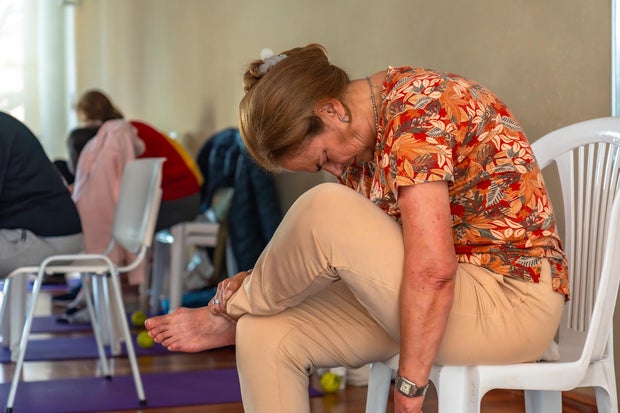Taking a moment to slow down your body and quiet your mind through stretching can be a beneficial step to add to your bedtime routine, movement experts say.
"Throughout the day, we accumulate tension whether from physical activity, prolonged sitting or mental stress. Taking a few minutes to stretch before bed offers a simple way to release that buildup, easing both body and mind into a restful state," Kat Pasle-Green, a personal trainer and coach at recreation company Bay Club who specializes in healthy sleep routines with her clients, told CBS News.
While stretching can benefit physical well-being by keeping muscles flexible and healthy, it can also support mental health, according to research. Studies have also shown stretching can help patients dealing with chronic insomnia.
Leading a busy life with working, commuting or parenting can leave people feeling disconnected from their bodies when it's time to go to sleep, Tim Kelleher, instructor and owner of Boston Yoga Union, told CBS News.
"The mind is racing around, the body is tired, but the two things don't seem to be able to communicate well enough with each other to just chill out and sleep," he said. "So any movement that you do that can help with that embodiment — to be more in your body is a really important piece of relaxation. Getting that harmony between your mental state and your physical self."
So if you're someone who lays in bed exhausted but can't quite cross over into sleep, "getting the body and mind on the same page before laying down can be really effective," he said.
Stretching before bed also offers a time to check in with how we feel, Pasle-Green added, something we might not get the opportunity to do throughout our day.
1. Forward fold: Whether standing with wide legs or sitting with your legs out in front of you, fold forward at your hips, creating a stretch.
"Oftentimes, any pose that incorporates or stretch that incorporates folding forwards can be really soothing for the system," Kelleher said, adding the physical sensation you feel during the stretch can give your mind something to focus on.
"We're not kind of worried about emails or what's coming next, or whatever the next steps in the evening routine are. We're just having an experience," he said, adding to incorporate a few deep breaths in this posture.
2. Seated ankle cross: While sitting on a bed, chair or couch, place one ankle on the opposite leg, as high as available, Pasle-Green explains, then lean forward with a long spine to move the chest as close to the top leg as is comfortable.
Hold for three deep breaths then switch legs and repeat as desired, she said.
 Side view of a senior woman sitting relaxed in yoga exercise to stretch the back
Getty Images
Side view of a senior woman sitting relaxed in yoga exercise to stretch the back
Getty Images
3. Chest opener: Sit tall and place your hands behind you on the bed or couch, fingers pointing away from you.
"Let your head relax back, opening your chest and front of your neck," Pasle-Green said. "To increase the stretch, you can finger-walk your hands further back or roll your head slightly side to side."
Hold this for three deep breaths.
4. Side stretch: While seated, place your right hand to your right and slide it away from you as you lean to the right, opening up your left side. You can also reach your left arm over your head and reaching it toward the right, Pasle-Green said.
"Breathe deeply throughout this stretch, keeping your body and your breath moving the whole time," she said, adding to repeat on each side.
 Side stretching on the floor.
Getty Images
Side stretching on the floor.
Getty Images
5. Hug stretch: While seated, wrap your arms around your rib cage in a big hug with each hand on the opposite side shoulder blade.
"Take a big breath in, and as you exhale, drop your chin toward your chest and round your spine forward as far as you can, pressing your bottom elbow toward your belly button," Pasle-Green said, adding to repeat while switching which arm is on top.
6. Twist pose: While laying on your back, hug your knees into your chest.
"Then drop both knees off to one side while you open up your arms nice and wide right and create some lateral flexion in the spine and a feeling of twist," Kelleher said.
 From this position, drop both knees off to one side while you opening your arms for a gentle spine twist.
PhotoAlto/Frederic Cirou
From this position, drop both knees off to one side while you opening your arms for a gentle spine twist.
PhotoAlto/Frederic Cirou
While any of these stretches can offer benefits throughout the day, Pasle-Green said they are most effective during the transition from activity to rest.
"By intentionally relaxing the body and mind right before sleep, our most impactful span of rest, we get a greater return on the time invested by greatly enhancing the quality of that rest," she said.
Before any of these stretches, Kelleher adds, it's important to put your phone away in order to prepare yourself to wind down.
"Give yourself a break from the onslaught of information," he said.
Sara Moniuszko




